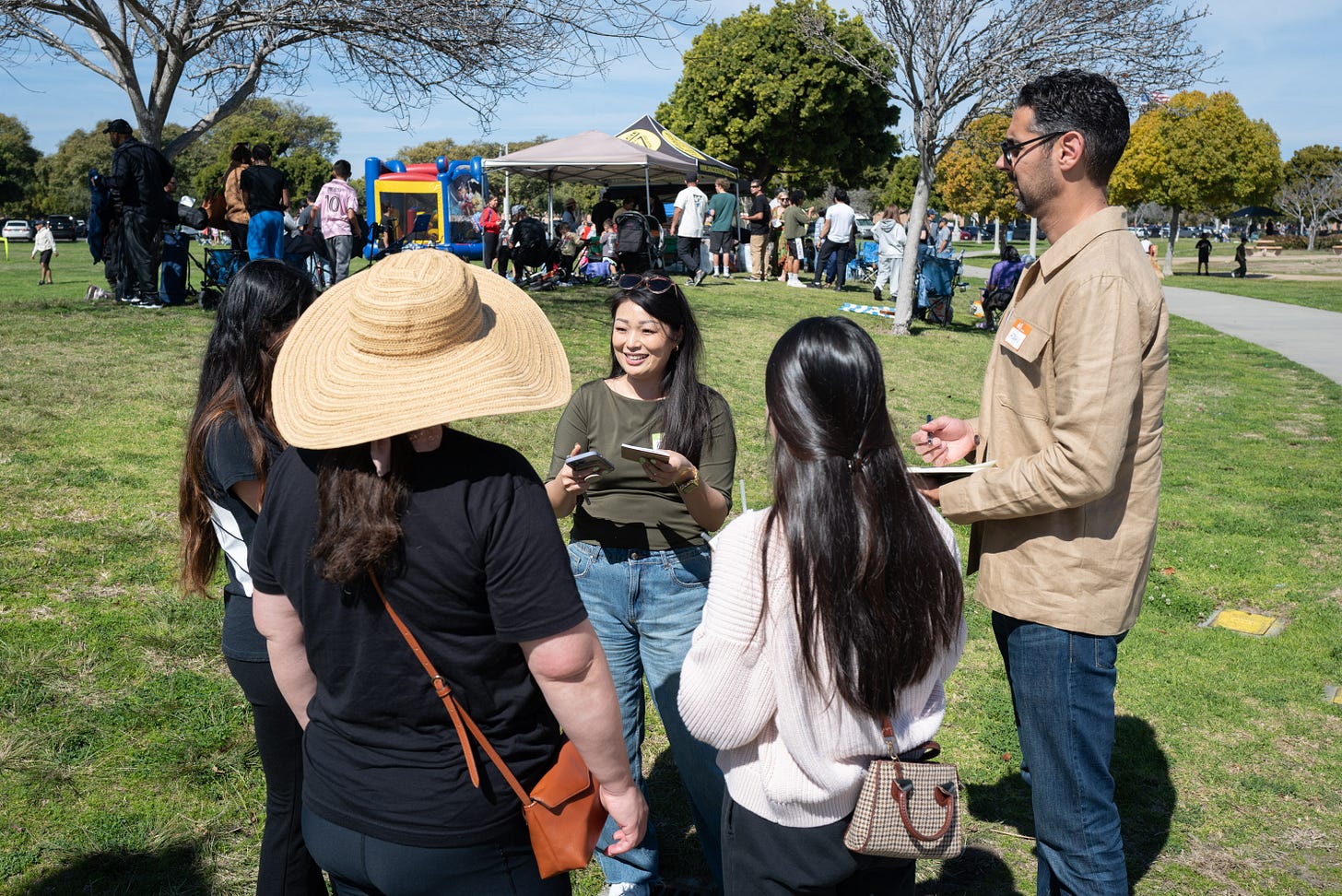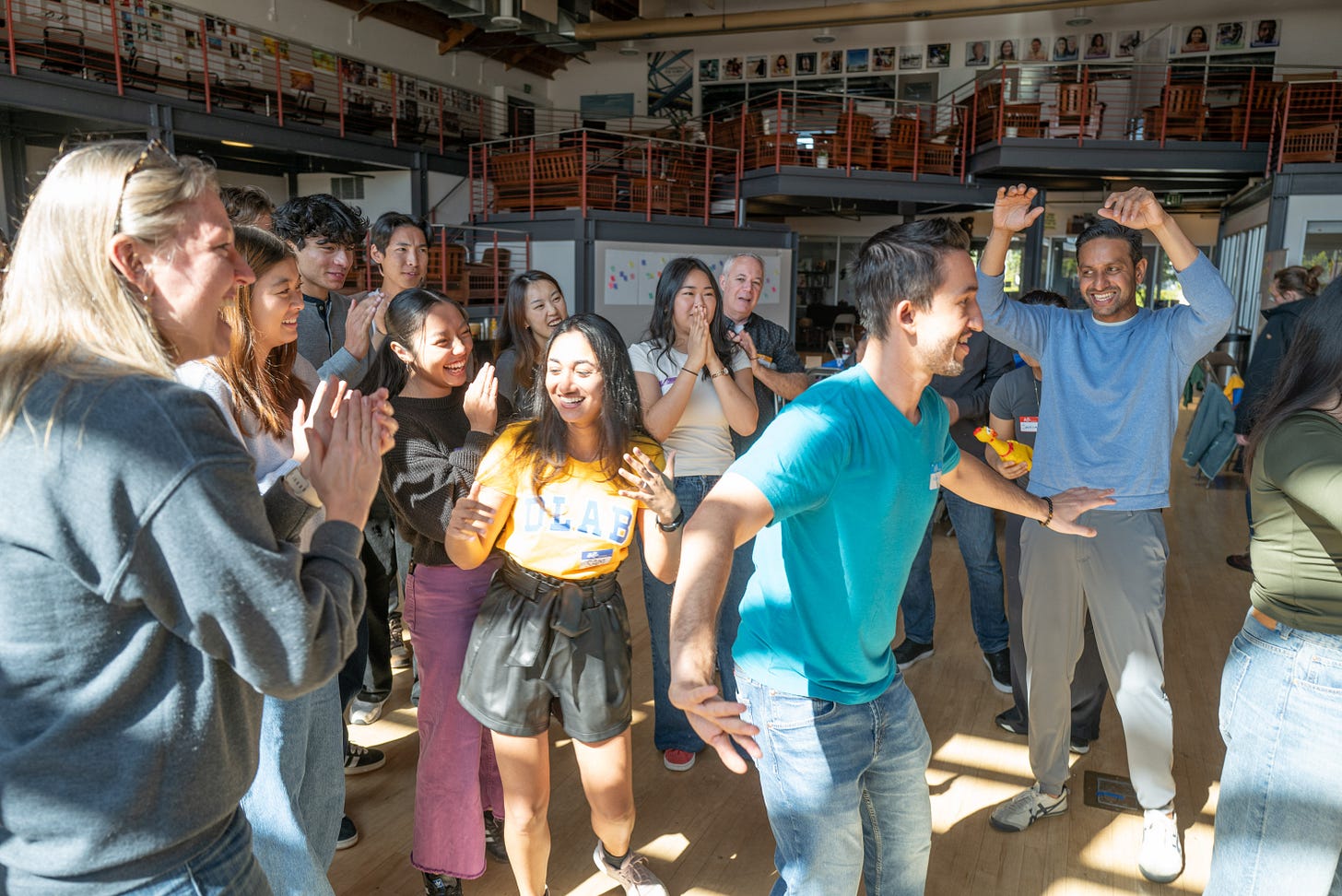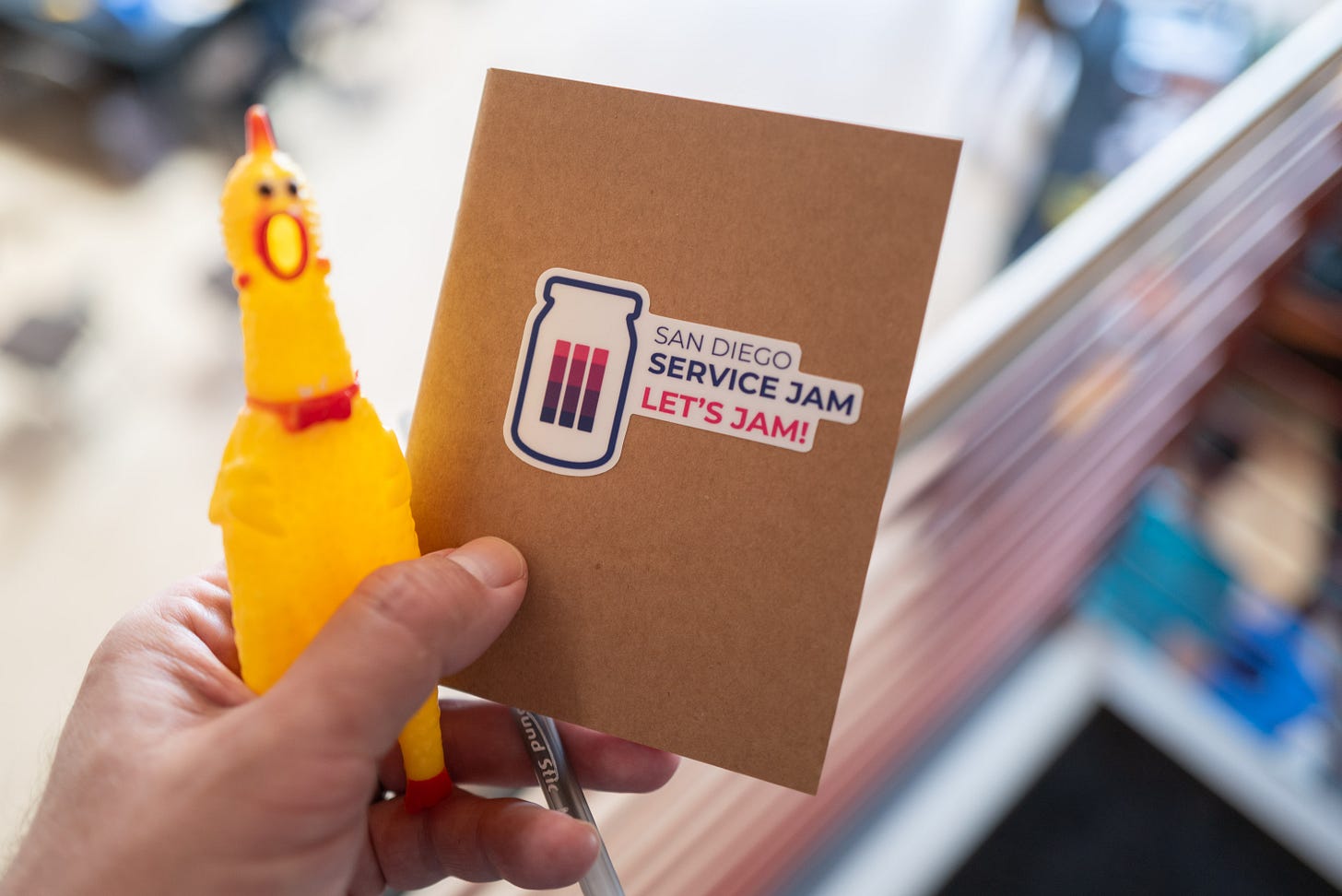The secret to great learning? Jammers show us how
Why Jammers loved SD Service Jam— and what we can learn from it
👋 Aloha! 🌺 Thanks for reading Learning, Designed. Welcome to the 10 new subscribers who joined our community in the last week. Reach out if I can help support or advance your work. We grew by 26 subscribers in February and are on track for some big goals in 2025! It’s not a numbers game (it’s an impact game), but it’s pretty exciting.
I’m writing because education wasn't designed around students, but we can improve the learner experience through design. I share stories, tips, and work in progress weekly.
Why it matters: Traditional networking and learning often fall short—Jammers showed that hands-on collaboration, real-world engagement, and shared experiences drive deeper learning and stronger connections. By focusing on doing, not just talking, Service Jam fosters confidence, skill-building, and community in a way that traditional events can't match. The result? A transformative model for designing learning experiences that are immersive, social, and high-impact.
Go deeper:
Last weekend I organized San Diego’s second Global Service Jam, a design event that takes place in 100+ cities around the world on the same weekend.
It’s a fun, interactive weekend-long service design “workshop” using design thinking tools like brainstorming, user research, and rapid prototyping & testing to design, test, and launch a new service in 48 hours.
I attended my first Jam in 2016 and have been jamming, coaching, and organizing ever since. In fact, my wife and I brought Service Jam from DC to and started the first event in San Diego in 2019. After a cancelled Jam in 2020 and a hiatus through the pandemic, it was time to bring it back in 2025 following SD-Tijuana’s designation as World Design Capital.
Who attends the Jam?
We’ve noticed that the Jam is most popular for new designers looking to break into design, and this year was no different. “Jammers,” as we call them, are often looking to build their portfolio with real experience and connect to other designers outside of traditional networking.
When we asked attendees to describe their level of experience with service design, 75% of survey respondents described themselves as “Beginner” or “Intermediate.”
Notably, being new to design doesn’t mean they are early in their career. In fact, half of survey respondents were early career or students, and half were mid-career or senior leaders.
Why did they attend the Jam?
In conversation with attendees as they arrived, I consistently heard Jammers describe an unmet need with traditional networking events, a vibrant part of the design community with several major meetup groups in San Diego with thousands of members and regular events.
They shared that they were new to design and didn’t know many people at most networking event and didn’t feel like they had anything to offer people they met or confident in talking about their work.
They were most excited about the Jam because it was an opportunity to “do” design with others while getting to know them. It felt more natural to connect with others while practicing design rather than the traditional networking format most commonly held in breweries or at a local company as the backdrop to a presentation or panel.
These themes surfaced indirectly through our pre-Jam survey, with “connecting to design practitioners and leaders” being the top goal for attending the Jam, followed by “connecting with aspiring designers” and “building their portfolio.”
On Sunday, I asked Jammers to share their highlights from the Jam and the results were insightful. Since, several Jammers have shared their highlights and summaries on Linkedin, take a look-- their stories are amazing!: Sarah, Jie, Desi, JeanMarie, Katherine, Aurora, Alisha, Anoushka, Ameer, Michael.
After reviewing their takeaways, it was clear Jammers were impacted by the event design. Below are a few of the insights backed by “voice of Jammer” you can use to improve your learning experiences.
What can we learn about creating impactful learning experiences?
What’s amazing about the Service Jam is while it offers structure, a few formal presentations, coaching, we most deliberating design for autonomy. Yes, there’s an agenda (click ‘view details’) that helps signal for meals and major milestones, but teams ultimately decide what they want to work on (based on very abstract, open themes), and self organize and navigate the weekend with strangers who become friends.
🦄 Here’s what Jammers said was “magic” about the Jam, relevant for any experience:
Impactful learning tip #1: Build culture through common values.
“The creativity, collaboration, and hashtag#DoNotTell spirit made for an unforgettable weekend—designing for real people and real problems at breakneck speed.”
We opened the event with rubber chickens, our universal symbol of play and explained their role in the weekend. Beforehand, we introduced coaches to the Jam norms of “doing, not talking,” (the official Jam motto), “show, don’t tell,” “test, learn, test” and “don’t yuck their yum.” These Jam “values” create norms and offer guidance that build and emphasize mindsets that are important to cultivate in the design process. They offer anchors, and shorthands, for teams to work and learn quickly through small nudges and common language.
Impactful learning tip #2: Create shared experiences and make learning social.
“I had such a fun time at the Jam this weekend! It was incredible to be able to collaborate with so many talented designers and work on tackling challenges as a team. The experience really pushed me to think outside of the box and connect with people who are passionate about design as well.”
People love connecting over a common goal. We’re social creatures and a shared experience and bond offer a powerful backdrop for connection and engagement. “Jammers” form teams on Friday night around their selected problem space through an interactive exercise (and a small preview into tools for prioritization). They work with a coach through the weekend and form relationships with the people they’re doing (and learning) design with. We integrated community building moments, icebreakers, and group fun throughout the weekend. Silliness is a powerful source of connection. These micro-moments and larger narratives create an arc of belonging and connection through the weekend that bonds people to the Jam.
Impactful learning tip #3: Let experts be experts, don’t over index on content.
“At first, it could feel daunting, but I felt so supported by the amazing coaches, my team, and the Jam community. At the end of this weekend, I left feeling re-inspired and more motivated than ever by seeing firsthand the power of design thinking!”
There are four 15-20 min “Flash Talks” throughout the weekend that are the basis for learning and accelerate teams through the process. No 90-min long lectures here! The bulk of the team’s work is largely done with a practitioner “coach” to offer guidance. This makes their learning and feedback targeted and relevant to what they’re trying to accomplish at any given time.
Additionally, the program itself is rather light, by design. Of course, with a talented facilitator and MC there is lots of energy management, community building, and reflection, but the emphasis (and motto) of the Jam is “doing, not talking,” and “show, don’t tell,” so teams manage their progress on their own and measure against the major milestones in the Jam to make sure their keeping up (and have support when they drift off track).
Impactful learning tip #4: Make learning relevant by bringing it to life.
“I honestly think my favorite part was being able to go out into the field to interviewing people.”
“As someone who learns by doing—not just sitting in a classroom and memorizing—I found the real-world experience here incredibly meaningful.”
“Beyond the methods and frameworks, my biggest takeaway was - design emerges from collaboration, playfulness, and a willingness to fail fast. You don’t just learn design—you do it, you live it.”

Jammers pick a real topic to work on in the real world using design tools. There are large chunks of the weekend designed to get teams to go out into the community and stop people on the street to interview them about their topic. They go out again once they’ve ideated and show their prototype to people, ask them to interact with it, and get feedback. We emphasize “doing, not talking,” as much as possible throughout the weekend, pushing teams to “go test it,” “show, don’t tell,” and learn through action (with the support of practitioner coaches).
We tell Jammers to tell people they’re “students in a class working on a project” to simplify their request to engage the community, and they’re consistently amazed with how willing people are to talk to them. Apart from the design process, it’s these little nuggets of insight that prepare them to be stronger designers— like, you have to get out into the world and engage people for their insight. The hardest part is getting started, so we give them 30 mins to develop their questions and then kick them out of the building (then learn and iterate later): doing, not talking. This is zone of proximal learning stuff 🤓
Impactful learning tip #5: Make time for reflection on the learning and the experience.
“[Among my highlights for the Jam were] insightful reflection sessions after each design stage and activity deepened our understanding”
Alongside major milestones in the experience we hit pause to come together as a group and ask Jammers to reflect on what they were learning through the experience. It helps not only integrate their own learning, but prompts insights across the group to reinforce concepts for everyone. We regularly asked questions like ‘What surprised them about their experience?’ ‘How will you use what they learned?’ ‘Did anyone else experience that?’
Mid way through the weekend, teams share what they’ve been working on and what they learned to get their encouragement and feedback. This exercise gets teams thinking about all of the work they’ve done and helps them reinforce and integrate their project and personal learnings.
Impactful learning tip #6: Adapt the experience to dynamic learner needs.
“Big shoutout to Michael Vargas for his elite MC and facilitation skills in leading us through the weekend.”

There’s a lot of thoughtfulness dedicated to reading the room and managing energy. We not only have an “MC” for the event, but someone who is keeping track of where teams are in the process and how they’re doing. In a delicate dance and coordination between organizers and MC, we’ll delay the start of a talk or extend a meal if people need a boost or some more downtime and collaborate on what should happen. We invest in team and community building throughout the weekend beyond the teaching. We’re whole people, and they’re attending to learn and do design, and to connect with one another through shared interests that go beyond design.
Impactful learning tip #7: Bring in the community, and make it high quality and affordable.
“It was inspiring to see the power of community and relationships unfold in real time and to build meaningful connections along the way. Maybe one day I’ll catch you both scaling this event across OC and LA! 😉”
“It was worth every penny! It was way more rewarding than the bootcamp I attended. It was real world experience!”
Because the Jam is a volunteer-run, budget neutral labor of love, it garners a lot of goodwill, that we don’t take lightly. People offer in-kind donations of meals, coffee, and space, and give up their weekend to invest in other designers. I’m always amazed by what people are willing to contribute to invest in others. But it’s proof you can organize people around investing in their community. We made this video at the end of the Jam to send to everyone who supported the event.
I spoke with multiple Jammers who spent thousands of dollars on in person design training ($14k) and online courses ($6k) who were amazed and appreciative that we could offer the Jam for the cost of food for the weekend ($59-69 tickets) supported by so many quality volunteer speakers and coaches.
Worth mentioning, the Jam is becoming a platform all its own with prompts for more collaboration and a network of folks interested in getting together to design in community in San Diego that just stopped by to hang out and support. Plant the flag and people will organize around it. Over time, the value proposition, brand positioning, and price will evolve and take care of itself (if it needs to).
A framework to make meaning of these learnings
What I learned from Miriam Swords Kalk at Education Design Lab about learner motivation remains true: growth-focused (supporting growth and self-efficacy), learner-driven (supports choice and buy-in), and belonging-oriented (supports connection and belonging) environments are powerful for engagement in learning.
Designing with these criteria can make impactful experiences! Need some help building your next event, class, program, or event? Reach out and let’s talk.
Insights from the Field
Bringing you voices from across education to answer:
What advice would you give to someone driving change in education?
“The world is changing too fast to live in disciplinary silos. Education needs to double down on intentionally and explicitly teaching durable, transferable skills.
To do this, start with purpose and build from first principles, not legacy structures. Set the vision around the kinds of humans you want to create, backward design the skills they need to be those people, and then build the experiences they’ll need to have so they can practice those skills across time and across contexts. Name the skills. They will be more granular than you think. “Be a better problem-solver” won’t do; teaching people to decompose a problem into its component parts (#breakitdown) or use analogical reasoning (#analogies) is much more helpful. Intentionally scaffold those skills throughout the learning journey and make them crystal clear to your learners. The skills should be the basis of active learning exercises, feedback, reflection, and assessment. They should be the red thread that ties diverse experiences together and a common language that unites your community.
In an increasingly complex world, learners need the agility of durable, transferable skills. They can acquire those skills haphazardly, but how might the world look if we taught them intentionally?“Christine Looser, Strategic Partnerships at Minerva Project
Sharing this with a colleague is the most meaningful way to show it made an impact.

Please click the ❤️ button on this post so more people can discover it on Substack. Tell me what you think in the comments!






